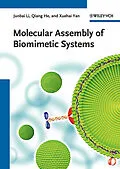In diesem Band werden moderne Methoden der Herstellung molekularer Aggregate für biotechnologisch relevante biomimetische Systeme (künstliche Proteine, Peptide, molekulare Motoren, photosensitive Systeme) vorgestellt. Der Schwerpunkt liegt dabei auf biomimetischen Membranen, Kapseln und Grenzflächen.
Autorentext
Junbai Li is a Director of the Key Lab of Colloid and Interface Science, Institute of Chemistry, Chinese Academy of Sciences (ICCAS). He received his BS and PhD degrees from Jilin University and spent two years as a Postdoctoral Fellow and Group Leader at the Max Planck Institute of Colloids & Surfaces, for the collaborative project Molecular Assembly of Biomimetic Systems. He then worked as a Full Professor at the Institute of Photographic Chemistry , CAS before moving to his current position in 1999. His research interests encompass supramolecular chemistry and surface science, including the boundary research areas of organic chemistry, physical chemistry, biochemistry, and materials chemistry. His major interests include the molecular assembly of biomimetic systems, biointerfaces, and nanostructures.
Qiang He graduated from the Inner Mongolia University and received his PhD degree on physical chemistry in 2003 from the Institute of Chemistry, the Chinese Academy of Sciences. Then he joined Prof. Li's group and became an associate professor in the Institute of Chemistry, the Chinese Academy of Sciences. He spent four years as a research fellow of the Alexander von Humboldt Foundation in the Max Plank Institute of Colloids and Interfaces, Germany. Currently, he is a full Professor at the Micro/Nano Technology Research Centre, Harbin Institute of Technology, China. His research interests include self-assembled active systems, stimuli-responsive surface patterning for biomedical applications.
Xuehai Yan received his BE degree in Chemical Engineering in 2002 and MS degree in Applied Chemistry in 2005 from China University of Mining and Technology. Then he joined the Institute of Chemistry, the Chinese Academy Sciences, where he obtained his PhD in Physical Chemistry in 2008. Currently he is working as a research fellow of the Alexander von Humboldt Foundation at the Max Plank Institute of Colloids and Interfaces in Germany. His research interests are focused on Self-assembly of biomolecular materials, in particular the use of amino acids or peptides as an assembly building block, and supramolecular interactions in the process of self-assembly.
Klappentext
In nature, biological systems and physiological processes have evolved over millions of years to improve their properties and functions. Biomimetics is the study and use of the structured and function of living things to create materials or products by reverse engineering. A major advantage of these systems is that both biochemical and physical parameters can be precisely controlled, therefore enabling the utilization of biomimetic systems experimental model s for guiding the research on the biological mutation and evolution in the organisms. Some bioactive molecular such as peptides, proteins, nucleic acids and lipids can undergo self-assembly into well defined structures similar to the assembly in living organs. Biomimetrics is not limited to just copying nature because with the development of modern biology, scientists can direct utilize biological units themselves to construct new types of systems sometimes as hybrid nanostructured materials. This book covers fundamental aspects and practical techniques of molecular assembly of biomimetic systems, especially, the layer-by-layer assembly, self-assembly, microcontact printing, electron beam lithography and chemical nanolithography. Aimed at graduate students as well as researchers carrying out research and development in nanotechnology, biotechnology and materials sciences.
Zusammenfassung
This handy reference details state-of-the-art preparation of molecular assemblies of biotechnologically relevant biomimetic systems (artificial proteins, peptides, molecular motors, photosensitive systems) with an emphasis on biomimetic membranes, capsules, and interfaces. Medical applications such as drug release, gene therapy, and tissue engineering as well as biosensing, biocatalysis, and energy storage are highlighted.
Inhalt
Preface.
Introduction.
Biomimetic Membranes.
Layer-by-Layer Assembly of Biomimetic Microcapsules.
FoF1-ATP Synthase-Based Active Biomimetic Systems.
KinesinMicrotubule-Driven Active Biomimetic Systems.
Biomimetic Interface.
Peptide-Based Biomimetic Materials.
1 Biomimetic Membranes.
1.1 Introduction.
1.2 Lipid Monolayers.
1.2.1 Phospholipid Monolayers at the Air/Water Interface.
1.2.2 Phospholipid Monolayers at the Oil/Water Interface.
1.2.3 Interfacial Behavior of Phospholipid Monolayers.
1.2.4 Protein Layers at the Oil/Water Interface.
1.2.4.1 Kinetics of Protein Adsorption.
1.2.4.2 Formation of Skin-Like Protein Films on a Curved Interface.
1.2.5 Interfacial Behavior of Phospholipid/Protein Composite Layers.
1.2.5.1 Dynamic Adsorption and Mechanism.
1.2.5.2 Assembly of Skin-Like Complex Films on a Curved Interface.
1.3 Modeling Membrane Hydrolysis In Vitro.
1.3.1 PLA2.
1.3.2 PLC.
1.3.3 PLD.
1.4 Polyelectrolyte-Supported Lipid Bilayers.
1.4.1 Polyelectrolyte Multilayers on Planar Surfaces.
1.4.2 Polyelectrolyte Multilayers on Curved Surfaces.
1.5 Conclusions and Perspectives.
References.
2 Layer-by-Layer Assembly of Biomimetic Microcapsules.
2.1 Introduction.
2.2 Layer-by-layer Assembly of Polyelectrolyte Multilayer Microcapsules.
2.2.1 General Aspects.
2.2.2 Permeation and Mechanical Properties of LbL Microcapsules.
2.3 Biointerfacing Polyelectrolyte Microcapsules A Multifunctional Cargo System.
2.3.1 Lipid Bilayer-Modifi ed Polyelectrolyte Microcapsules.
2.3.2 Formation of Asymmetric Lipid Bilayers on the Surface of LbL-Assembled Capsules.
2.3.3 Assembly of Lipid Bilayers on Covalently LbL-Assembled Protein Capsules.
2.4 Application of Biomimetic Microcapsules.
2.4.1 Integrating Specifi c Biofunctionality for Targeting.
2.4.2 Adsorption of Antibodies on the Surface of Biomimetic Microcapsules.
2.5 Conclusions and Perspectives.
References.
3 FoF1-ATP Synthase-Based Active Biomimetic Systems.
3.1 Introduction.
3.2 FoF1-ATPase A Rotary Molecular Motor.
3.2.1 Structure of H+FoF1-ATPase.
3.2.2 Direct Observation of the Rotation of Single ATPase Molecules.
3.3 Reconstitution of FoF1-ATPase in Cellular Mimic Structures.
3.3.1 FoF1-ATPase-incorporated Liposome A Classical Biomembrane Mimic.
3.3.1.1 Bacteriorhodopsin uses Light to Pump Protons.
3.3.1.2 Proton Gradients Produced by Artificial Photosynthetic Reactions.
3.3.2 ATP Biosynthesis from Biomimetic Microcapsules.
3.3.2.1 Generation of Proton Gradients in Polymer Capsules by the Change of pH Values.
3.3.2.2 Proton Gradients in Protein Capsules Supplied by the Oxidative Hydrolysis of Glucoses.
3.3.2.3 Proton Gradients Generated by GOD Capsules.
3.3.3 Reassembly of FoF1-ATPase in Polymersomes.
3.4 Conclusions and Perspectives.
References.
4 KinesinMicrotubule-Driven Active Biomimetic Systems.
4.1 Introduction.
4.2 KinesinMicrotubule Active Transport Systems.
4.3 Active Biomimetic Systems Based on the KinesinMicrotubule Complex.
4.…
